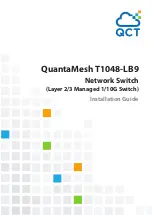
Chapter 14
| Multicast Filtering
Layer 2 IGMP (Snooping and Query for IPv4)
– 398 –
multicast router receives this solicitation, it immediately issues an IGMP general
query.
A query solicitation can be sent whenever the switch notices a topology
change, even if it is not the root bridge in spanning tree.
◆
Router Alert Option
– Discards any IGMPv2/v3 packets that do not include the
Router Alert option. (Default: Disabled)
As described in Section 9.1 of RFC 3376 for IGMP Version 3, the Router Alert
Option can be used to protect against DOS attacks. One common method of
attack is launched by an intruder who takes over the role of querier, and starts
overloading multicast hosts by sending a large number of group-and-source-
specific queries, each with a large source list and the Maximum Response Time
set to a large value.
To protect against this kind of attack, (1) routers should not forward queries.
This is easier to accomplish if the query carries the Router Alert option. (2) Also,
when the switch is acting in the role of a multicast host (such as when using
proxy routing), it should ignore version 2 or 3 queries that do not contain the
Router Alert option.
◆
Unregistered Data Flooding
– Floods unregistered multicast traffic into the
attached VLAN. (Default: Disabled)
Once the table used to store multicast entries for IGMP snooping and multicast
routing is filled, no new entries are learned. If no router port is configured in the
attached VLAN, and unregistered-flooding is disabled, any subsequent
multicast traffic not found in the table is dropped, otherwise it is flooded
throughout the VLAN.
◆
Forwarding Priority
– Assigns a CoS priority to all multicast traffic. (Range: 0-7,
where 7 is the highest priority; Default: Disabled)
This parameter can be used to set a high priority for low-latency multicast
traffic such as a video-conference, or to set a low priority for normal multicast
traffic not sensitive to latency.
◆
Version Exclusive
– Discards any received IGMP messages which use a version
different to that currently configured by the IGMP Version attribute. (Default:
Disabled)
◆
IGMP Unsolicited Report Interval
– Specifies how often the upstream
interface should transmit unsolicited IGMP reports when proxy reporting is
enabled. (Range: 1-65535 seconds, Default: 400 seconds)
When a new upstream interface (that is, uplink port) starts up, the switch sends
unsolicited reports for all currently learned multicast channels via the new
upstream interface.
This command only applies when proxy reporting is enabled.
Summary of Contents for GEL-1061
Page 14: ...Contents 14...
Page 28: ...Section I Getting Started 28...
Page 38: ...Chapter 1 Introduction System Defaults 38...
Page 40: ...Section II Web Configuration 40...
Page 60: ...Chapter 2 Using the Web Interface Navigating the Web Browser Interface 60...
Page 164: ...Chapter 6 Address Table Settings Issuing MAC Address Traps 164...
Page 192: ...Chapter 8 Congestion Control Storm Control 192...
Page 204: ...Chapter 9 Class of Service Layer 3 4 Priority Settings 204...
Page 216: ...Chapter 10 Quality of Service Attaching a Policy Map to a Port 216...
Page 430: ...Chapter 14 Multicast Filtering MLD Snooping Snooping and Query for IPv4 430...
Page 436: ...Chapter 15 IP Tools Address Resolution Protocol 436...
Page 474: ...Section III Appendices 474...
Page 492: ...Glossary 492...
Page 500: ...E052016 ST R02 150200001416A...
















































